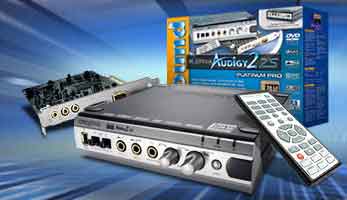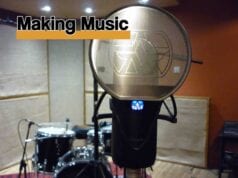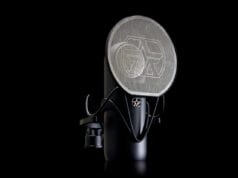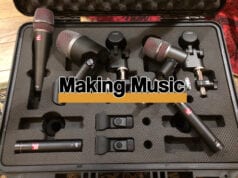Last Updated on October 8, 2016 by Andrew Culture
Creative Labs’ new top-of-the-range sound card is the company’s most advanced card yet. Is it a blast from the past or a fillip for the future…
Information

Product: Audigy 2 ZS Platinum Pro
Manufacturer: Creative Labs
Price: $199 £149
Web: Creative
Creative Labs’ range of Sound Blaster digital audio cards has probably been used by more home-based musicians than any other card. The combination of features, the wealth of bundled software and good quality audio at a fair price made them very attractive.
The Sound Blaster range continues to develop and the latest addition to the franchise is, to give it its full title, the Sound Blaster Audigy 2 ZS Platinum Pro. Phew!
Installation is straightforward although if you’re replacing an existing card, particularly an older Sound Blaster, it’s a good idea to make sure all vestiges of earlier software, especially drivers, have been removed.
As well as the main card, there is a joystick/MIDI interface on a flying lead which needs an adjacent backplane slot, plus the External I/O Hub which connects to the card via a special AD_LINK cable. The Hub is a stand-alone box which would sit on top of or alongside your PC. Some earlier Sound Blaster models had an internal Hub that fitted inside a drive bay in the PC which was neat but that’s not an option here.
Surrounded by sound
The Speaker Settings application lets you adjust your speaker configuration by selecting the type of speaker system you have and adjusting the volume and cutoff frequency of the subwoofer. You can use it test your speakers, control the bass boost, and activate and deactivate the digital output.
The card itself has just three line out sockets which are used to hook up a range of speakers. The user guide shows connection options for a various surround sound formats including 7.1, 6.1, 5.1, 4.1 and 2.1 (which is good ol’ stereo to most of us) using, of course, various Creative speaker models as examples. The card also supports stereo and 5.1 surround digital formats using connections from the Hub.
Although you can use the card for stereo, it’s a shame to miss out on its surround sound potential. If you’ve been tempted to explore surround formats but haven’t quite managed to get around to it, this card may be the impetus you need to give it whirl.
Centre of all things
The Hub is the, er, hub of all connectivity. It features two FireWire connectors, Optical in and out, a digital out, S/PDIF in and out, MIDI in and out, three analogue outs and a headphone socket. You also get an infra red remote control in case you can’t reach the Hub or your mouse, that controls CD tracks and various sound options.




Possibly of major interest to musicians are three pieces of music software – Cubasis VST 4.0 CE, WaveLab Lite 2.0, and FL Studio 4 CE. CE (Creative Edition) means that the software will only run with the Creative card so if you change cards you’ll need to buy new software, too. FL (Fruity Loops) Studio is a powerful, if somewhat idiosyncratic, pattern-based sequencer with plug-in support for VST instruments and effects.
Cubasis VST and WaveLab are music tools in a more traditional vein. Unless you have specific or demanding requirements, the Cubasis VST sequencer should be able to handle most music projects. It’s interesting to reflect that Cubasis is probably ten times more powerful than the original Cubase software! WaveLab Lite is an audio editor and while it lacks some of the major features of its big brother it’s still a powerful and usable program.
How low can you go
The ASIO 2.0 drivers for the card offer very low latency, possibly as low as 2ms, although how low you can go will depend on your system. The card supports digital audio up to 24-bit 96kHz with a claimed SNR (signal-to-noise ratio) of 108dB. Subjectively, the output is excellent although it’s worth bearing in mind that while the card has many features of especial interest to the musician, it was not designed specifically for musicians but for four purposes – music creation, music listening, games and movies.
If you bear that in mind, you’ll be able to appreciate some of the card’s other features such as EAX 4.0 for games (the main new feature here is the Multi-Environment which layers multiple environment audio effects in real-time), its THX certification for cinematic audio, and the CMSS (Creative Multi Speaker Surround) 3D audio technology that allows stereo recordings to be played back in surround sound.


In many ways, the Audigy 2 ZS Platinum Pro is an evolution rather than a revolution and if you already have an Audigy 2 card, you may not see too many benefits by upgrading to this one. However, we understand that the new drivers work with the Audigy 2 – but we can’t be held responsible if they don’t! – so they may be worth seeking out.
If your main requirement is for an audio card specifically for music making, the Audigy 2 ZS Platinum Pro may have too many bells and whistles for you, and if you prefer single-minded simplicity, you may be better off with a dedicated card aimed squarely at the pro audio market. However, if you also use your PC for serious music listening, playing DVDs, watching movies, and for playing games then you’ll struggle to find a better all round card.
Pros
Good sound quality
7.1 surround sound
Lots of software
Excellent multi-purpose card
Cons
Not a dedicate card for making music
Summary
The Audigy 2 ZS Platinum Pro is an impressive all-round audio card suitable for making music as well as games, playing audio and watching movies.
8/10
Minimum system requirements
PC: Pentium III 500MHz/AMD 700MHz, 128Mb RAM for Windows 98/Me, 256Mb RAM for Windows 2000/XP, 600Mb HD space
Features
24-bit 96kHz digital audio
External I/O Hub
ASIO 2.0 drivers
FireWire interface
Dolby Digital Surround Sound 5.1, 6.1 and 7.1
SoundFont support

















